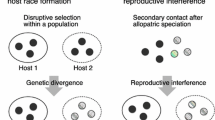Abstract
The aim of this study was to test the predictions of local mate competition (LMC), host quality (HQ) and operational sex ratio (OSR) models, using a non-arrhenotokous parasitic mite, Hemisarcoptes coccophagus (Astigmata: Hemisarcoptidae). The life-history pattern of this mite meets the assumptions of these sex allocation models. Mating group size (LMC model), HQ and OSR affected the sex allocation of H. coccophagus females. Only young mite females adjusted the sex ratio of their progenies according to the predictions of LMC and HQ models; the sex allocation of old females was contrary to these predictions. We explain these patterns by the dynamic nature of the mite's population structure. When parents are young, their population distribution is patchy and progeny matings are local; hence sex allocation is in accordance with LMC theory. When parents become older, their populations shift towards panmixis; factors which had operated previously no longer exist. Consequently, females adjust the sex ratio of late progenies so that it can compensate for the earlier sex allocation, in order to make their total sex ratio unbiased, as expected in panmictic populations. Our data, expressed as the cumulative sex ratio, support this hypothesis.
Similar content being viewed by others
References
Charnov EL (1979) The genetical evolution of patterns of sexuality: Darwinian fitness. Am Nat 113: 465–480
Charnov EL, Los-Den Hartogh RL, Jones WT, Assem J van den (1981) Sex ratio evolution in a variable environment. Nature 289: 27–33
Eguaras M, Marcangeli J, Fernandez NA (1994) Influence of “parasitic intensity” on Varroa jacobsoni Oud. reproduction. J Apicult Res 33: 155–159
Fisher RA (1930) The general theory of natural selection. Clarendon, Oxford
Gerson U, OConnor BA, Houck MA (1990) Acari. In: Rosen D (ed) Armored scale insects: their biology, natural enemies and control, vol 4B. Elsevier, Amsterdam, pp 77–97
Hamilton WD (1967) Extraordinary sex ratios. Science 156: 477–488
Izraylevich S, Gerson U (1993) Mite parasitization on armored scale insects: host suitability. Exp Appl Acarol 17: 861–875
Izraylevich S, Gerson U (1994) Host-scale effects on the parasitic mite Hemisarcoptes coccophagus Meyer and their implications for the biological control of diaspidid pests. Isr J Entomol 29: 291–296
Izraylevich S, Gerson U (1995) Sex ratio of Hemisarcoptes coccophagus, a mite parasitic on insects: density-dependent processes. Oikos 74: 439–446
Izraylevich S, Hasson O, Gerson U (1995) Frequency-dependent host selection by parasitic mites: a model and a case study. Oecologia 102: 138–145
Izraylevich S, Gerson U, Wysoki M (1995) Karyotype and the sex determining mechanism of the mite Hemisarcoptes coccophagus Meyer (Acariformes: Astigmata: Hemisarcoptidae). Int J Acarol 21: 229–232
Nagelkerke CJ, Sabelis MW (1991) Precise sex ratio control in the pseudoarrhenotokous phytoseiid mite Typhlodromus occidentalis Nesbitt. In: Murphy PW, Schuster R (eds) The Acari: reproduction development and life-history strategies. Ellis Horwood, Chichester, pp 193–207
Sabelis MW (1985) Sex allocation. In: Helle W, Sabelis MW (eds) Spider mites: their biology, natural enemies and control, vol 1B. Elsevier, Amsterdam, pp 83–94
Sokal RR, Rohlf FJ (1981) Biometry. Freeman, San Francisco
Werren JH, Charnov EL (1978) Facultative sex ratios and population dynamics. Nature 272: 349–350
Wrensch DL, Bruce WA (1991) Sex ratio, fitness and innate capacity for increase in Pyemotes tritici (Acari: Pyemotidae). In: Murphy PW, Schuster R (eds) The Acari: reproduction development and life-history strategies. Ellis Horwood, Chichester, pp 209–221
Wrensch DL, Young SSY (1978) Effects of density and host quality on rate of development, survivorship and sex ratio in the carmine spider mite. Environ Entomol 7: 499–501
Young SSY, Wrensch DL, Kongchuensin M (1986) Control of sex ratio by female spider mites. Entomol Exp Appl 40: 53–60
Zaher MA, Shehata KK, El-Khatib H (1979) Population density effects on biology of Tetranychus arabicus, the common spider mite in Egypt. Recent Adv Acarol 1: 507–509
Author information
Authors and Affiliations
Corresponding author
Rights and permissions
About this article
Cite this article
Izraylevich, S., Gerson, U. Sex allocation by a mite parasitic on insects: local mate competition, host quality and operational sex ratio. Oecologia 108, 676–682 (1996). https://doi.org/10.1007/BF00329042
Received:
Accepted:
Issue Date:
DOI: https://doi.org/10.1007/BF00329042




